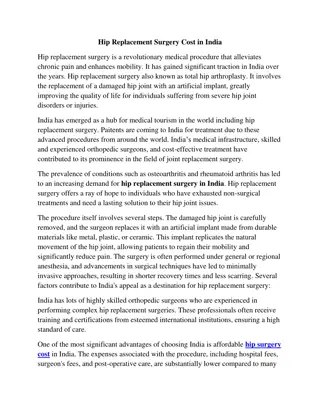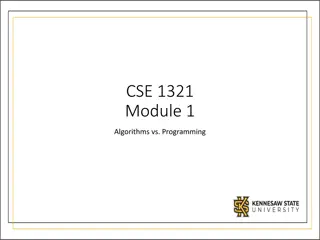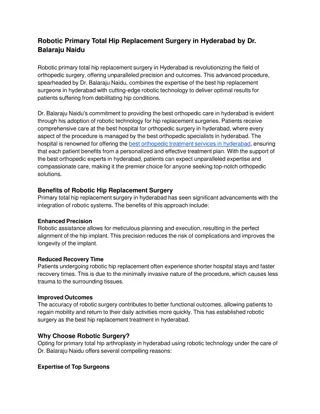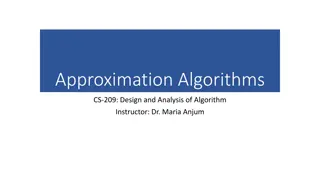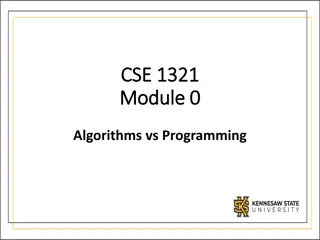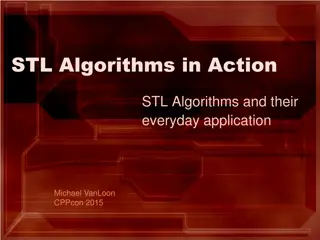Page Replacement Algorithms Overview
The Optimal Page Replacement Algorithm aims for the best possible replacement scenario, though impossible to implement practically. The Not Recently Used (NRU) algorithm categorizes pages based on their referenced and modified statuses, removing a page at random from the least active class. It helps the operating system to manage memory efficiently. Explore various page replacement algorithms to optimize memory usage in virtual memory systems.
Download Presentation

Please find below an Image/Link to download the presentation.
The content on the website is provided AS IS for your information and personal use only. It may not be sold, licensed, or shared on other websites without obtaining consent from the author.If you encounter any issues during the download, it is possible that the publisher has removed the file from their server.
You are allowed to download the files provided on this website for personal or commercial use, subject to the condition that they are used lawfully. All files are the property of their respective owners.
The content on the website is provided AS IS for your information and personal use only. It may not be sold, licensed, or shared on other websites without obtaining consent from the author.
E N D
Presentation Transcript
Page Replacement Page Replacement Algorithms Algorithms
The Optimal Page Replacement Algorithm The Optimal Page Replacement Algorithm The best possible page replacement algorithm is easy to describe but impossible to implement. It goes like this. At the moment that a page fault occurs, some set of pages is in memory. One of these pages will be referenced on the very next instruction (the page containing that instruction). Other pages may not be referenced until 10, 100, or perhaps 1000 instructions later. Each page can be labeled with the number of instructions that will be executed before that page is first referenced. The only problem with this algorithm is that it is unrealizable. At the time of the page fault, the operating system has no way of knowing when each of the pages will be referenced next. Ali Akbar Mohammadi 2
The Not Recently Used(NRU) Page Replacement The Not Recently Used(NRU) Page Replacement Algorithm Algorithm In order to allow the operating system to collect useful statistics about which pages are being used and which ones are not, most computers with virtual memory have two status bits associated with each page. R is set whenever the page is referenced (read or written). M is set when the page is written to (i.e., modified). Ali Akbar Mohammadi 3
The Not Recently Used(NRU) Page Replacement The Not Recently Used(NRU) Page Replacement Algorithm Algorithm The operating system then sets the R bit (in its internal tables), changes the page table entry to point to the correct page, with mode READ ONLY, and restarts the instruction. If the page is subsequently written on, another page fault will occur, allowing the operating system to set the M bit as well and change the page's mode to READ/WRITE. Ali Akbar Mohammadi 4
The Not Recently Used(NRU) Page Replacement The Not Recently Used(NRU) Page Replacement Algorithm Algorithm When a page fault occurs, the operating system inspects all the pages and divides them into four categories based on the current values of their R and M bits: Class 0: not referenced, not modified. Class 1: not referenced, modified. Class 2: referenced, not modified. Class 3: referenced, modified. Ali Akbar Mohammadi 5
The Not Recently Used(NRU) Page Replacement The Not Recently Used(NRU) Page Replacement Algorithm Algorithm The NRU (Not Recently Used) algorithm removes a page at random from the lowest numbered nonempty class. Implicit in this algorithm is that it is better to remove a modified page that has not been referenced in at least one clock tick (typically 20 msec) than a clean page that is in heavy use. The main attraction of NRU is that it is easy to understand, moderately efficient to implement, and gives a performance that, while certainly not optimal, may be adequate. Ali Akbar Mohammadi 6
The First The First- -In, First Algorithm Algorithm In, First- -Out (FIFO) Page Replacement Out (FIFO) Page Replacement The operating system maintains a list of all pages currently in memory, with the page at the head of the list the oldest one and the page at the tail the most recent arrival. On a page fault, the page at the head is removed and the new page added to the tail of the list. When applied to computers the same problem arises. For this reason, FIFO in its pure form is rarely used. Ali Akbar Mohammadi 7
The Second Chance Page Replacement Algorithm The Second Chance Page Replacement Algorithm A simple modification to FIFO that avoids the problem of throwing out a heavily used page is to inspect the R bit of the oldest page. If it is 0, the page is both old and unused, so it is replaced immediately. If the R bit is 1, the bit is cleared, the page is put onto the end of the list of pages, and its load time is updated as though it had just arrived in memory. Then the search continues. Ali Akbar Mohammadi 8
Operation of Second Chance. Operation of Second Chance. (a) Pages Sorted in FIFO Order. (a) Pages Sorted in FIFO Order. (b) Page List if a Page Fault Occurs at Time 20 and (b) Page List if a Page Fault Occurs at Time 20 and A A has its has its R R Bit Set. Bit Set. Ali Akbar Mohammadi 9
The Clock Page Replacement Algorithm The Clock Page Replacement Algorithm Ali Akbar Mohammadi 10
The Least Recently Used (LRU) Page Replacement The Least Recently Used (LRU) Page Replacement Algorithm Algorithm A good approximation to the optimal algorithm is based on the observation that pages that have been heavily used in the last few instructions will probably be heavily used again in the next few. Conversely, pages that have not been used for ages will probably remain unused for a long time. This idea suggests a realizable algorithm: when a page fault occurs, throw out the page that has been unused for the longest time. This strategy is called LRU (Least Recently Used) paging. Ali Akbar Mohammadi 11
LRU using a matrix when pages are referenced LRU using a matrix when pages are referenced in the order 0, 1, 2, 3, 2, 1, 0, 3, 2, 3. in the order 0, 1, 2, 3, 2, 1, 0, 3, 2, 3. Ali Akbar Mohammadi 12




